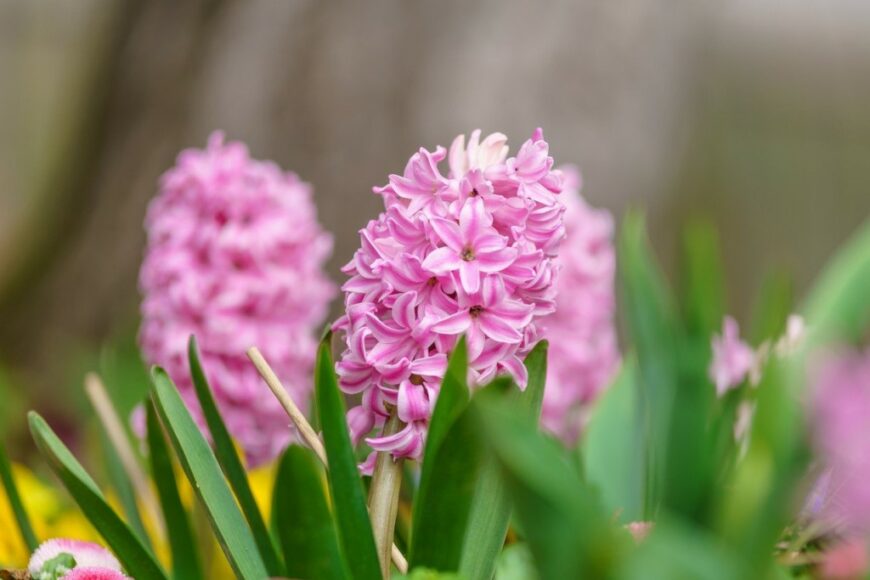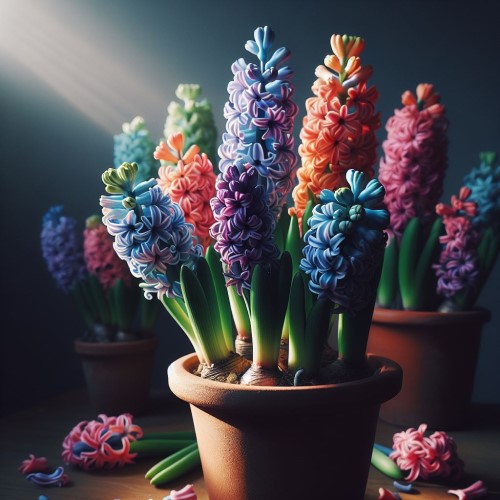
 Name: Hyacinths (Hyacinthus)
Name: Hyacinths (Hyacinthus) Family: Asparagaceae
Family: Asparagaceae Origins: Mediterranean region and parts of the Middle East
Origins: Mediterranean region and parts of the Middle East Humidity: Moderate to high humidity
Humidity: Moderate to high humidity Location: Full sun to partial shade
Location: Full sun to partial shade Soil: Well-draining soil with a neutral to slightly acidic pH
Soil: Well-draining soil with a neutral to slightly acidic pH Pests and diseases: Common pests include aphids and bulb mites; susceptible to diseases like botrytis and bacterial soft rot
Pests and diseases: Common pests include aphids and bulb mites; susceptible to diseases like botrytis and bacterial soft rot Care: Provide regular watering, avoid waterlogging, and fertilize during the growing season. Allow the foliage to wither naturally after blooming. Lift and divide bulbs every few years.
Care: Provide regular watering, avoid waterlogging, and fertilize during the growing season. Allow the foliage to wither naturally after blooming. Lift and divide bulbs every few years. Height of growth: 6 to 12 inches (15 to 30 cm)
Height of growth: 6 to 12 inches (15 to 30 cm) Planting in the soil: Plant bulbs in the fall, about 4 to 6 inches (10 to 15 cm) deep, and space them about 4 to 6 inches (10 to 15 cm) apart.
Planting in the soil: Plant bulbs in the fall, about 4 to 6 inches (10 to 15 cm) deep, and space them about 4 to 6 inches (10 to 15 cm) apart. Blooming: Spring, typically March to April, producing fragrant, colorful spikes of flowers.
Blooming: Spring, typically March to April, producing fragrant, colorful spikes of flowers.The hyacinth, a beloved flower native to the Eastern Mediterranean region, has been gracing gardens and homes for centuries with its captivating fragrance and vibrant colors. With its delicate bell-shaped blossoms clustered in racemes, the hyacinth is a symbol of spring’s awakening, filling the air with a sweet, intoxicating aroma. Its versatility allows it to be enjoyed indoors as potted bulbs or outdoors as garden accents, adding a touch of elegance and charm to any setting.
Content:
Botanical Overview
Hyacinths belong to the Liliaceae family and are characterized by their bulbous roots, narrow, sword-shaped leaves, and fragrant, clustered flowers. The genus Hyacinthus comprises over 30 species, but the most commonly cultivated variety is Hyacinthus orientalis, known for its wide range of colors and strong scent.

Flower Structure and Diversity
Hyacinth flowers are typically bell-shaped, with six tepals (sepals and petals fused together) that form the floral cup. The florets, arranged in a raceme or spike, can vary in color from white, yellow, pink, and red to deep blues and purples. The flowers are often fragrant, with some varieties releasing a sweet, intoxicating aroma that fills the air.
Bulb Structure and Growth
Hyacinth bulbs are oval or round, with layered fleshy scales that store nutrients for the plant’s growth and reproduction. Each bulb produces several slender, strap-shaped leaves that emerge from the base of the stem. The stem supports the raceme or spike of flowers, which typically blooms in late spring or early summer.
Cultivar Diversity and Varieties
There are numerous cultivars of hyacinth, each with unique characteristics in terms of color, fragrance, and flower shape. Some popular cultivars include:
- ‘Delft Blue’: A classic variety with deep blue flowers and a strong fragrance.
- ‘Pink Sensation’: A stunning variety with large, vibrant pink flowers and a sweet, delicate scent.
- ‘L’Ane Bleu’: A rare and sought-after variety with pale blue flowers and a distinctive fragrance.
- ‘Pink Pearl’: A petite variety with delicate pink flowers and a subtle fragrance.
Cultural Requirements for Successful Cultivation
Hyacinths are relatively easy to grow and can be cultivated in various settings, including indoor pots and outdoor gardens. Some key cultural considerations for successful hyacinth cultivation include:
- Light: Hyacinths prefer bright, indirect sunlight. Overexposure to direct sunlight can scorch the leaves.
- Soil: Hyacinths thrive in well-draining, fertile soil with a slightly acidic pH. Amend the soil with organic matter, such as composted manure, to improve drainage and nutrient content.
- Watering: Water hyacinths regularly during their growing season, keeping the soil moist but not soggy. Reduce watering once the flowers have faded to prepare the bulbs for dormancy.
- Fertilization: Fertilize hyacinths with a balanced liquid fertilizer every few weeks during their growing season. Avoid overfertilization, as this can lead to bulb rot or nutrient burn.
- Pests and Diseases: Hyacinths are generally resistant to pests and diseases, but they may be susceptible to aphids, snails, and slugs. Monitor the plants regularly and treat infestations promptly with appropriate organic or inorganic controls.
Propagation and Bulb Division

Hyacinths can be propagated by dividing their bulbs. After the flowers have faded, allow the foliage to yellow and die back naturally. Gently excavate the bulbs, carefully separating the largest, healthy bulbs for propagation. Plant the separated bulbs in a pot or garden bed, allowing them to mature for one to two years before flowering.
Harvesting and Storage
Hyacinths can be harvested for their fragrant flowers by cutting the stems when the flowers are fully open. Place the cut stems in a vase with fresh water, and enjoy their beauty for several days. To store hyacinth bulbs, allow them to dry out completely before storing them in a cool, dry place.
Hyacinths in Gardens
Hyacinths are beautiful additions to garden borders, rock gardens, and containers. They can be planted in groups or as accents to other flowering plants. For a stunning display, consider planting hyacinth bulbs in drifts along walkways or under trees.
Forcing Hyacinths Indoors
Forcing hyacinths indoors involves inducing them to bloom early by simulating the cooler temperatures and natural dormancy period they would experience in the spring. This method can be used to enjoy hyacinths in bloom during the winter months.
Steps for Forcing Hyacinths Indoors:
- Choose healthy hyacinth bulbs: Select firm, plump bulbs with no signs of damage or decay.
- Prepare the bulbs: Remove the bulbs from their packaging and check for any signs of rot or pests. Trim the roots slightly and place the bulbs in a shallow dish with shallow water, ensuring the base of the bulb is just barely submerged.
- Chill the bulbs: Place the dish in a cool, dark location, ideally between 35-45°F (2-7°C). Maintain this temperature for at least 8-12 weeks, allowing the bulbs to go through a period of cold dormancy.
- Transfer to pots: Once the shoots have emerged and reached a few inches in height, transfer the bulbs to individual pots filled with well-draining potting mix. Water the pots thoroughly and place them in a bright, indirect light location.
- Enjoy the blooms: Your hyacinths should begin to bloom within a few weeks. Enjoy their vibrant colors and sweet fragrance for several weeks.
FAQs
How long do hyacinths last?
Hyacinth flowers typically last for 2-4 weeks indoors.
How can I prevent my hyacinths from flopping over?
To prevent hyacinths from flopping over, provide support for the stems as they grow taller. You can use stake or bamboo sticks to prop up the stems.
What should I do with the hyacinth bulbs after flowering?
After the flowers have faded, allow the foliage to turn yellow and die back naturally. Once the foliage is dry, you can store the bulbs for planting outdoors the following season.

